 |
|
||||
| Previous | Gallery | Next |
 |
 |
|
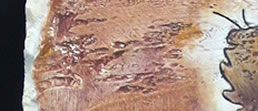 |
 |
|
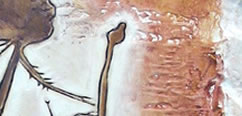 |
||
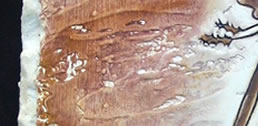 |
||
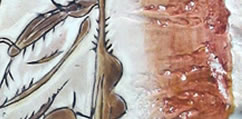 |
||
 |
||
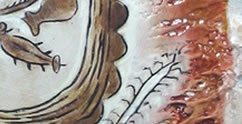 |
||
 |
||
 |
||
 |
YAM FIGURE COMPOSITION COLORS included in this piece are ground clay, cayenne pepper, raw sienna, raw umber and dirt from Sedona , Arizona , and yellow ochre. Ochre is a naturally-occurring earth pigment. In the bush the Aboriginals would collect dust of particular ants’ nets, fungus and minerals to create the yellow color. BACKGROUND is eggshell. TEXTURING is very unusual--the gypsum creating “pocked marks” as it was applied adding subtleness to the artwork, in contrast to the border which is very jagged and rock-like in appearance. SIZE is 15 ½” H x 12”W CULTURAL INSPIRATION: From the Arnhem Land Plateau comes the “Yam figures”, some of the most puzzling images of rock art. Anthropomorphized yams or “Yam people”, and the Rainbow Snake have several manifestations. The first simple images were of yams, but then developed into human and animal beings. Aboriginal informants identify two-yam forms: “garrbarda”, the long yam and “anginjdjek”, the round yam. Yams are found in the tropical north end of Australia and are among some of the world’s earliest flowering plants. During the dry season the plant is dormant, as it requires some 120 centimeters of annual rainfall. Yams are often used for ceremonial purposes and possess poisonous properties. The main image in this composition is the yam-headed being extending its hand over a snake. The snake may be a representation of the knobby body Rainbow Snake with its serrated tail but missing is the macropod-like head that is usually associated with this art style. Associated with the main design are the subsidiary designs—a lizard, two smaller snakes, a flying fox, fish and a centipede. Aboriginal informants explain that these belong to the Rainbow. According to E.J. Brandl, who was a Senior Research Officer with the Northern Territory Division, Department of Aboriginal Affairs, in Darwin , the yam figures are of antiquity. Many of the yam figure paintings are affected by mineral displacement, a chemical process that forms a whitish coating. This hydrated calcium aluminum phosphate is known to cover many of the oldest paintings. |